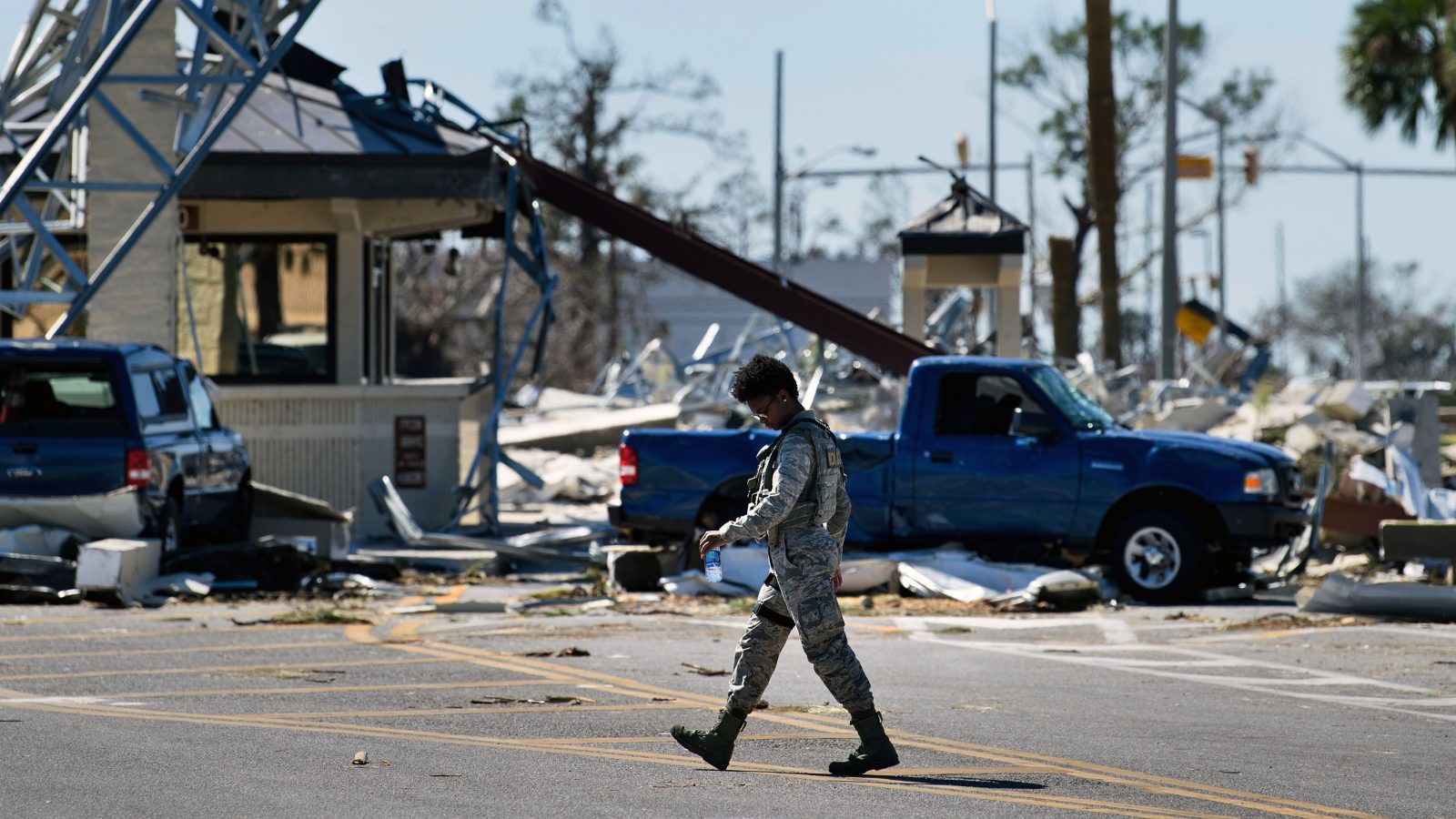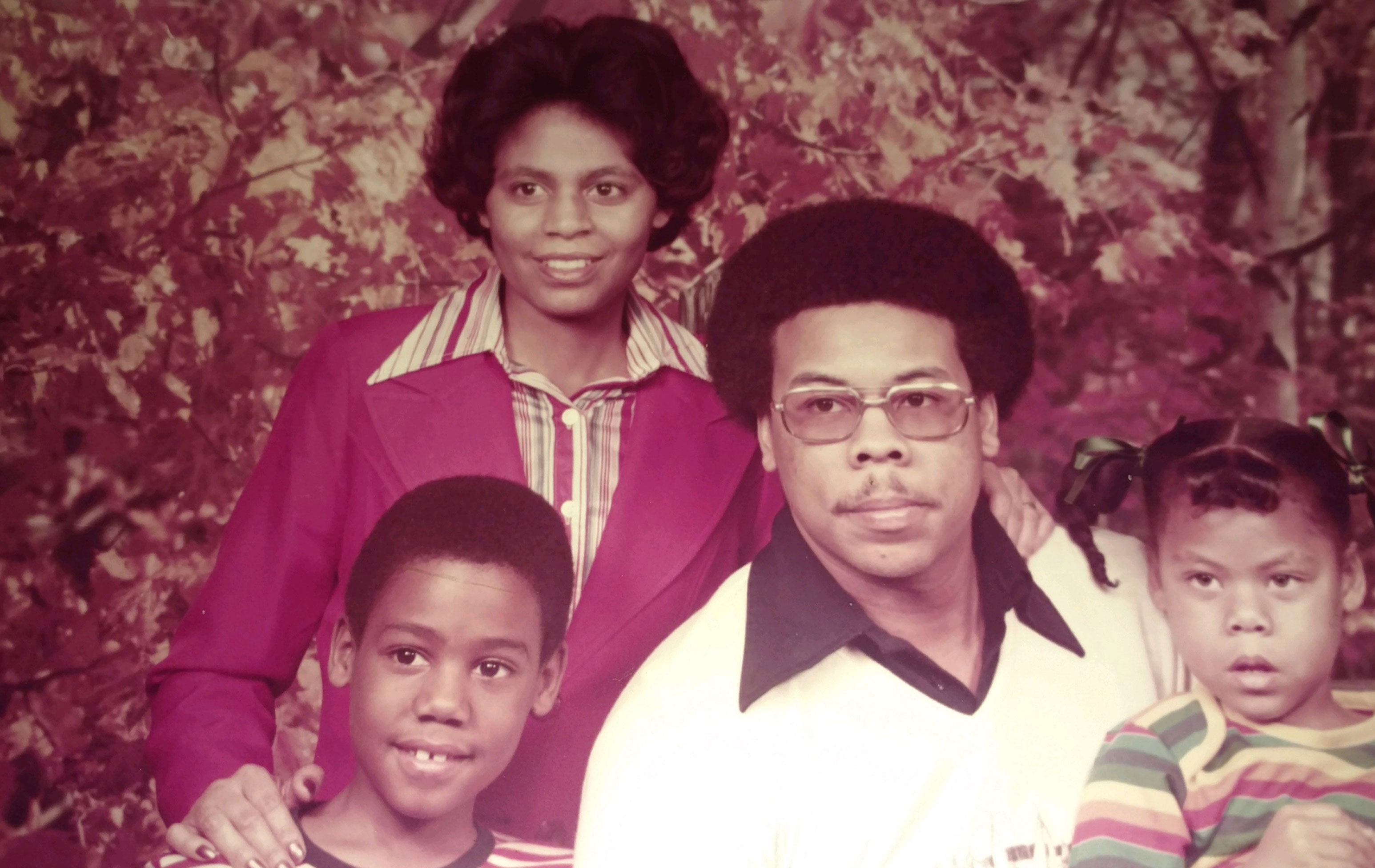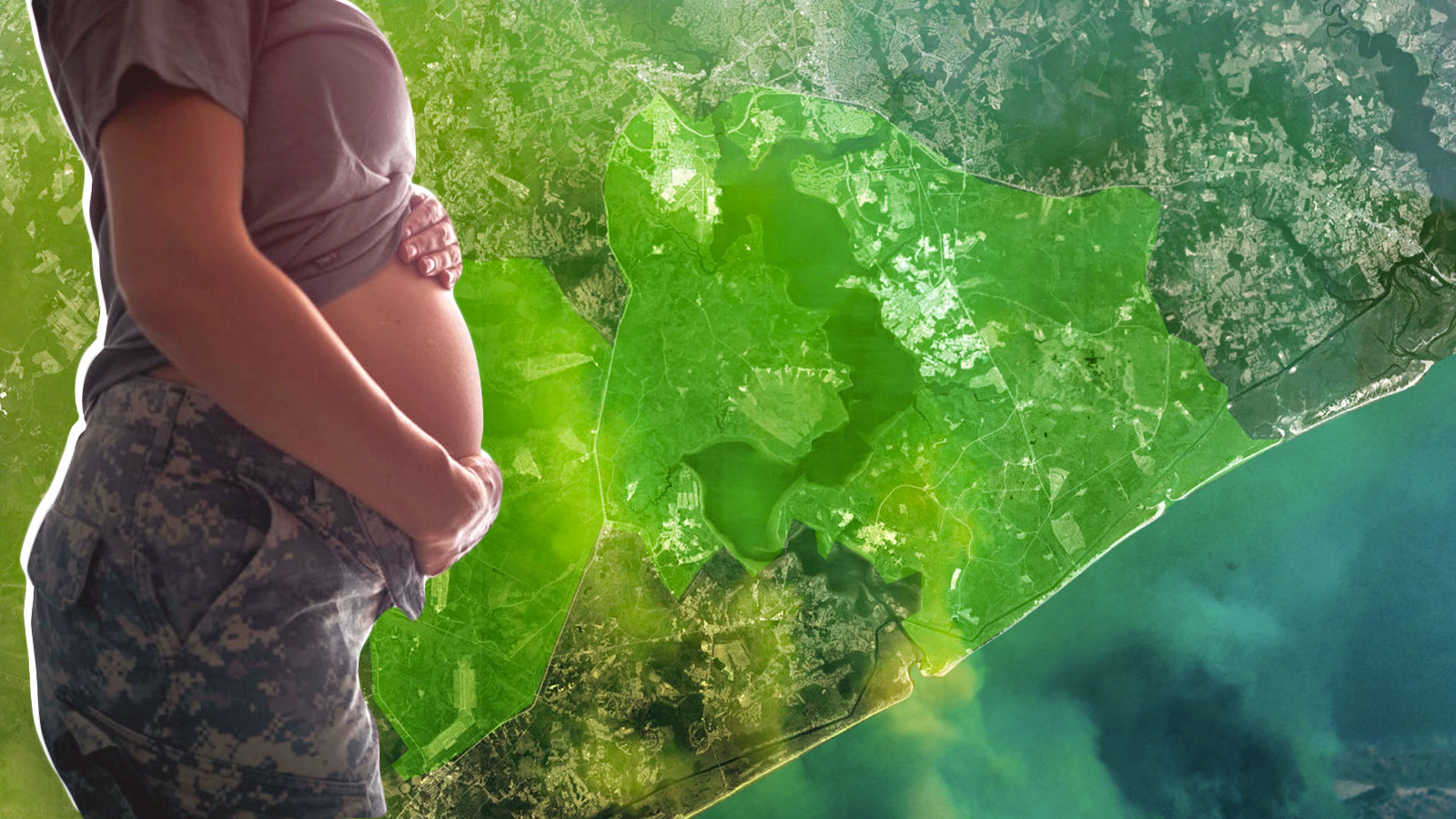Marine Corps Sergeant Peggy Price was six months pregnant when she arrived at Camp Lejeune in the 1980s with her husband, a fellow Marine. Serving as a cryptologic linguist, she never imagined the most immediate threats she would face would come from being stationed in Jacksonville, North Carolina.
“When you’re [stationed] stateside and you’ve got your family living with you, you don’t expect that that actually could be more dangerous than some of these overseas assignments,” Price said.
Price was one of approximately 900,000 people on and around the base who were exposed to drinking water contaminated with industrial solvents (including known carcinogens like trichloroethylene and benzene) between the 1950s and 1980s. The contaminants on base were associated with long-term health problems such as miscarriages, birth defects, and various types of cancer.

Peggy Price, when she was a Sergeant stationed at Camp Lejeune. Peggy Price
Price gave birth to her first child and became pregnant with a daughter while at Camp Lejeune. Now 61, Price has wrestled with decades of ailments. She has survived breast cancer, skin cancer, open heart surgery, a brain tumor, and reproductive health problems that led to a total hysterectomy. Price’s four kids have their own troubles. Her daughter had an ovary removed when she was 16 because of ovarian cysts. Her son who was born on the base developed a rare cancer when he was 13. Another child was diagnosed with autism.
For a while, she attributed her family’s health problems to bad luck. Then, she learned about the contaminated water at Camp Lejeune.
Although Camp Lejeune is said to be one of the worst water contamination cases in U.S. history, it’s far from the only toxic military site. There are currently 128 military installations on the Environmental Protection Agency’s list of Superfund sites — places so contaminated with hazardous substances that the federal government has placed them on a “National Priorities List” for cleanup. About 80 percent of federal Superfund sites are associated with the Department of Defense (that accounts for about 10 percent of all Superfund sites, including those stemming from private entities).
But even as cleanups on military bases move forward, extreme weather events and sea-level rise threaten to spread existing contamination to surrounding towns. A report released by the Defense Department earlier this year found that two-thirds of all military bases are vulnerable to the effects of climate change. Despite that recognition, critics have argued that the report fell short of addressing the full impact climate change is likely to have on the country’s military installations. The report makes no mention of how military Superfund sites might be compromised.
“This is endangering you, it’s endangering your family, and you’re not even going to know,” said Price.
Just following orders
So what makes military sites so potentially toxic?
Jennifer Liss Ohayon, a postdoctoral research fellow at both the Silent Spring Institute and Northeastern University, says daily operations and transportation, training exercises, and experiments are all common sources of industrial contamination. Flame retardants saturate soil at some bases. Others store radioactive waste or unexploded ordinances such as missiles and landmines. A 2003 report by the Government Accountability Office found that as much 15 million acres of land in the U.S. is contaminated from military munitions.
At Camp Lejeune, spills and leaks from underground storage equipment led to the contamination of on-base water sources with trichloroethylene. Another major source of pollution came from a dry cleaner that improperly disposed of chemicals like perchloroethylene, a volatile organic compound that’s been linked to cancer after long-term exposure, which was used to clean service members’ uniforms.
And then there’s the waste left behind by weapons. In Vieques, Puerto Rico, the U.S. military conducted training exercises — target practice, weapons testing, and massive bombing — for over 60 years. Although records are incomplete, it’s been estimated that almost 3 million pounds of “ordinance” were dropped on the island every year between 1980 and 2000, exposing the 9,000 people still living on the island to contaminants like napalm, Agent Orange, and depleted uranium.
“People do underestimate what a massive problem our military sites are in terms of their contribution to pollution in the United States,” said Ohayon, who studied the sites as part of her doctoral dissertation at the University of California, Santa Cruz.
At last count, more than 2.5 million personnel live and work on military installations across the United States, along with 1.4 million dependents. While branches of the military like the Air Force take personal preference into consideration when assigning someone to a base, the needs of the military always come first. That means many active-duty personnel don’t necessarily have a choice where they’re stationed — even if it means that they and their families may be living among hazardous waste.
‘Forever’ chemicals
As Peggy Price learned from her experience at Camp Lejeune, the dangers posed by chemicals we use or consume every day don’t always come to light until much later. One growing concern around military bases today is the presence of poly- and perfluorinated alkyl substances, or PFAS. They’re sometimes called “forever chemicals” because of how long they persist in the environment. This class of synthetic chemicals has been used for decades to make everyday items more heat or water-resistant (think non-stick pans).
The use of PFAS-laden firefighting foam has placed some military communities at risk of high levels of PFAS exposure. Last spring, the Pentagon revealed that it found potentially dangerous levels of the chemicals in drinking water at 126 military sites. Shortly afterward, the Agency for Toxic Substances and Disease Registry, or ATSDR, released a report finding that PFAS in drinking water can be hazardous at concentrations even 10 times lower than the Environmental Protection Agency’s current recommendation.
Some advocates have accused the Trump administration of trying to hold back information about PFAS contamination. Emails obtained by the Union of Concerned Scientists through a Freedom of Information Act request documented concerns by some administration officials about releasing the report. In one email, a White House aide wrote, “The impact to EPA and [the Defense Department] is going to be extremely painful. We (DoD and EPA) cannot seem to get ATSDR to realize the potential public relations nightmare this is going to be.”
The Union of Concerned Scientists also studied water samples from 131 U.S. military sites and found that a majority contained PFAS levels up to 100 times above what the ATSDR report identified as a safe amount.
“There are individuals who have come back from serving abroad and thought they were safe and instead were drinking contaminated water for years and are only just finding out about it,” Genna Reed, lead science and policy analyst at the Union of Concerned Scientists, told Grist.
Defense Department spokesperson Heather Babb told Grist in an email that the department has provided bottled water and filters to people, and that it plans to focus on addressing contaminants in soil and groundwater once it has eliminated exposure to the two most common types of PFAS chemicals. “We take our responsibility seriously,” said Babb. “Where DoD is the source of Perfluorooctane sulfonate (PFOS) and Perfluorooctanoic acid (PFOA), our first priority is to ensure humans are not drinking water above the EPA’s Lifetime Health Advisory.”
Even though it has set non-enforceable guidelines, the EPA has yet to establish legal limits on PFAS in water. In February, the agency announced an “action plan” for the substances. But Reed and other critics say the plan amounted to kicking the regulatory can further down the road.
Meanwhile, the ATSDR announced in February that it will conduct assessments near military installations to get a better understanding of risks associated with exposure to PFAS.
Climate change as a threat multiplier
Climate change is making the pollution at Superfund sites a much bigger, broader problem.
In 2017, the Associated Press published an investigation that found 327 Superfund sites vulnerable to flooding and sea-level rise — posing health risks to 2 million Americans who live within a mile of these toxic sites.
Grist compared those sites to those connected to the Department of Defense and found that 17 military Superfund sites on the AP’s list are at risk from flooding and sea-level rise. By the AP’s count, 51,387 people live within a one-mile radius of these 17 sites.
Recent hurricanes like Harvey and Maria have called attention to the dangers Superfund sites can pose in the wake of a disaster. After Harvey laid waste to Harris County, Texas, in August 2017, reports abounded of the “toxic stew” of contaminated flood water. Seven Superfund sites in the county were flooded (Harris County has more than two dozen). At the San Jacinto waste pits just outside of Houston, a “protective cap” sealing off a dangerous chemical compound was damaged. That led to a release of dioxins, which have been linked to cancer, reproductive, developmental, hormonal, and immunological problems.
After the storm subsided, EPA divers in Harris County recorded dioxin levels from river sediment at concentrations more than 2,000 times higher than the agency typically allows.
A month later, Hurricane Maria hit Puerto Rico, leaving millions of Americans without electricity or access to clean water. CNN reported that residents without bottled water were drinking water from one of the local Superfund sites.
There’s no shortage of information that shows the military is both responsible for pollution at many of these sites and vulnerable to extreme weather events exacerbated by climate change. The EPA’s website states, “Remedies at contaminated sites may be vulnerable to the impacts of climate change and extreme weather events.” It lists heavy rains, floods, landslides, along with more frequent and intense storms and wildfires as ways that climate change can wreck efforts to remediate Superfund sites.
And even though the Defense Department may be one of the only agencies under the Trump administration that’s actually talking about climate change, some critics say it still isn’t acknowledging the full scope of the issue.
When the Department of Defense released its report on the “effects of a changing climate” in January, it didn’t include an assessment of any Marine Corps bases — including Camp Lejeune. Critics quickly pointed out the omission. Senator Jack Reed, a Democrat from Rhode Island, said the report offered “about as much value as a phonebook,” Mother Jones’ Dan Spinelli reported.
Two weeks later, House Democrats called on the Pentagon to produce a new report on how climate change threatens the country’s military operations and installations. When Grist contacted the Department of Defense to ask about a possible timeline for a new report, the department spokesperson said, “As with all Congressional correspondence, we will respond directly to the authors of the letter.”
In an email to Grist, the EPA acknowledged the danger climate change poses to Superfund sites. The Superfund program takes both climate change and weather science into account “as a standard operating practice in cleanup projects,” they wrote. That approach includes the “screening of Superfund remedy vulnerabilities, prioritizing the Agency’s adaptation efforts at Superfund sites, and identifying adaptation measures to increase remedies’ resilience to climate change and extreme weather.”

A military police officer walks near a destroyed gate in Tyndall Air Force Base in Florida in the aftermath of Hurricane Michael in October 2018. Brendan Smialowski / AFP / via Getty Images
Camp Lejeune suffered $3.6 billion of damage when it flooded during Hurricane Florence in September 2018. The following month, Hurricane Michael damaged pretty much every structure at Florida’s Tyndall Air Force Base — another Superfund site — and nearly wiped the surrounding community of Panama City. (Luckily there were no reported toxic releases at these bases.)
Limiting future toxic exposures at military sites will require planning for the additional challenges associated with climate change. But for those already exposed, seeking redress has been another battle.
Waiting for justice
More than 30 years after many of them had been exposed to contaminants on base, veterans who served at Camp Lejeune became eligible in 2012 to receive health and disability benefits related to the toxins. But not everyone has access to those benefits. Only those with at least one of 15 specific conditions were offered health care; those diagnosed with at least one of eight types of cancers and diseases qualify for disability benefits. Peggy Price’s ailments, which she believes are related to her time at Lejeune, weren’t on the list.
“It’s just a further slap in the face,” said Price. “I don’t even get the title of disabled veteran.”
The U.S. Department of Veterans Affairs wrote to Grist that it “encourages all Veterans who feel their military service has affected their health to submit a claim, which will be adjudicated using the latest scientific and medical evidence available.”
Some veterans have sought justice in the courts: 4,500 plaintiffs filed civil claims against the Navy because of the water at Camp Lejeune. But in January, the Navy announced that it will deny all claims and not pay out the estimated $963 billion in damages. (The Navy did not respond to Grist’s request for comment by the time of publication.)
One of the reasons for the denials is a North Carolina law that only gives plaintiffs 10 years after an injury occurs to file a civil suit — even though many of the people who struggled with their health after living or working at Camp Lejeune didn’t learn about the contaminated water until decades later.
That’s what happened to Louella Holliday. She lived at Camp Lejeune with her husband from 1973 to 1976.

Louella Holliday with family while they were living at Camp Lejeune. Louella Holliday
During her time there, Holliday became pregnant with her third child. She was hospitalized at least two dozen times throughout the pregnancy and weighed just 95 pounds at the time she gave birth, two months prematurely. The baby died 15 hours later. After losing the child, Holliday continued to have such severe menstrual cramps that, like Peggy Price, she eventually had a hysterectomy.
For more than 20 years, Holliday says she wondered constantly what she had done wrong to lose the baby. Camp Lejeune had been listed as a Superfund site by the Environmental Protection Agency since 1989. But Price and Holiday say they didn’t learn that their health battles could have stemmed from the water at Camp Lejeune until 2000, after the U.S. Marine Corps held a press conference announcing that it was trying to reach thousands of people who may have been drinking tainted water. Each saw the story on the news.
“I realized, it’s not me. It was what I was exposed to,” said Holliday, now 69. “After finally having some relief, I got mad. They knew everything that was going on and they didn’t bother to tell anybody.”
Price and others have called for greater government transparency about the chemicals to which Americans are exposed. Price recently added her voice to growing concerns about PFAS. Thanks to mounting public pressure, the EPA is reviewing whether it should regulate chemicals like PFAS under the Superfund statute and in our drinking water. It’s expected to make a decision by the end of the year.
Price has this message for policymakers: “Put some money where [your] mouth is and show the military that [you] actually do care,” she said. “It’s not just about the latest weapons and the high-tech gadgets. It’s about making where you put your military personnel safe places.”




